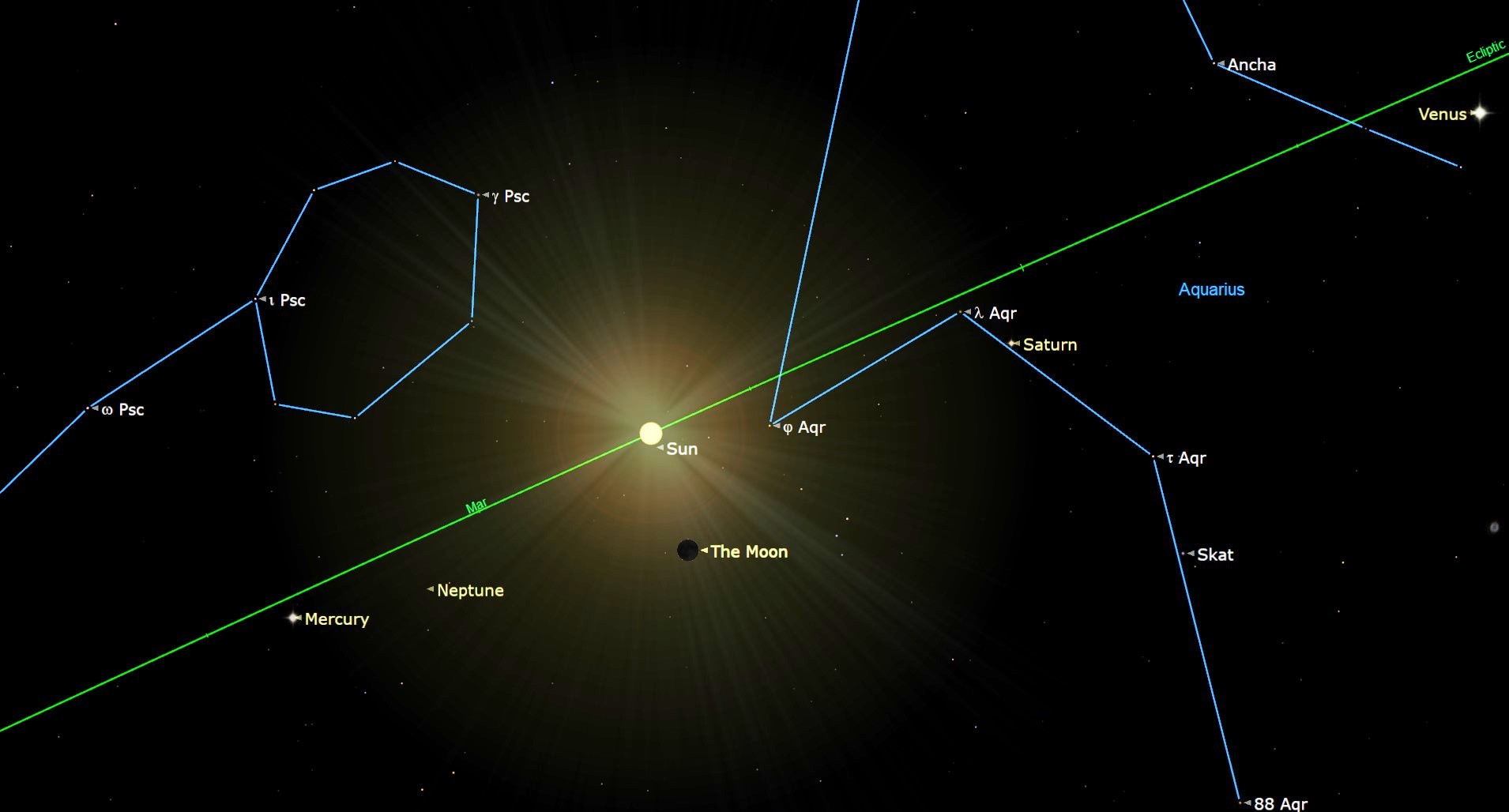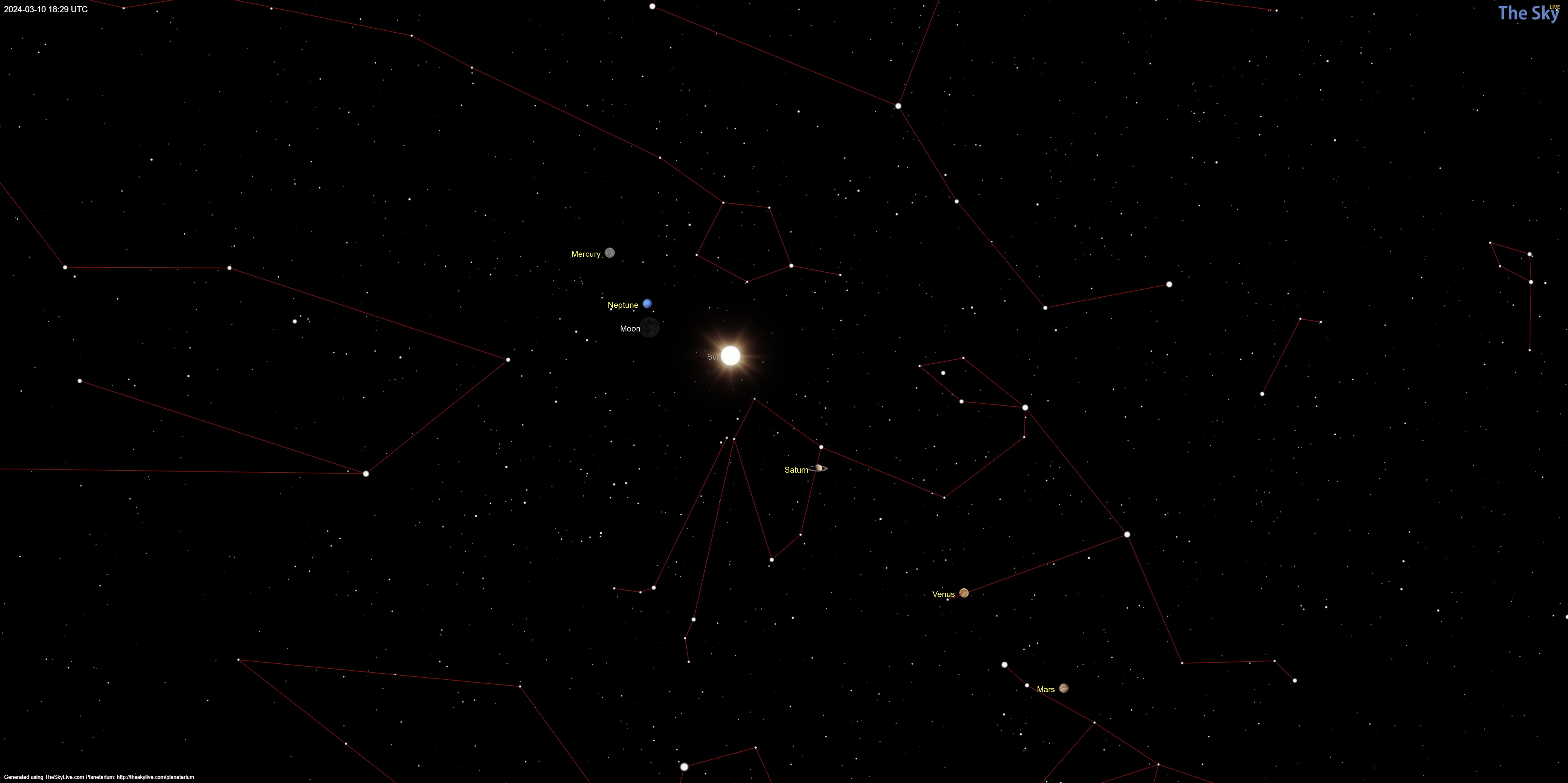The new moon lets the winter constellations shine tonight

March's new moon rises today, making this a great dark night to observe the winter constellations before they leave the night sky.
The new moon occurs March 10, at 5:00 a.m. EDT (0900 UTC), according to the U.S. Naval Observatory. two days after the waning moon has a conjunction with Mars and Venus and three days ahead of a conjunction with Jupiter.
A new moon is called that because it is at the start of a lunation (a lunar cycle). At that point the moon is directly between Earth and the sun, which happens about every 29.5 days. The two bodies share the same celestial longitude, a projection of the Earth's own longitude lines on the celestial sphere. This alignment is also called a conjunction; if the moon happens to pass in front of the sun we see a solar eclipse, but that isn't going to happen this time (the next one is slated for April 8 and will be visible over much of the United States).
Timing of lunar phases depends on the position of the moon, so the difference in the hour between locations on Earth is due to one's time zone.
Related: Full moon calendar 2024: When to see the next full moon

Looking for a telescope to see the features of the full moon up close? We recommend the Celestron Astro Fi 102 as the top pick in our best beginner's telescope guide. Don't forget a moon filter!
New moons make for great skywatching nights. If you want to take a look at the dark night sky up close, our guides to the best telescopes and best binoculars are a great place to start.
And whether you want to image the moon or to explore the night sky in general, check out our guide on how to photograph the night sky or how to photograph the planets, as well as our recommendations for the best cameras for astrophotography and best lenses for astrophotography.
Get the Space.com Newsletter
Breaking space news, the latest updates on rocket launches, skywatching events and more!
New moons are often used in lunar calendars; though historically their timing has to be estimated because they aren't visible. However, it is possible to catch the moon a day or two ahead of or after the new phase; the moon appears as a very thin crescent. Ancient astronomers, in fact, used it to determine the first days of the month, and in countries where Islam is an important part of civil life Islamic scholars still do; the traditional Jewish calendar also reckons months from the new moon, as does the Chinese lunar calendar.
An interesting exercise is to see if one can catch the moon just after the new moon; looking to the sky just after sunset on March 10 or March 11; the crescent is thin but it is sometimes just visible. (Be careful when observing anything close to the sun; using any optical aid is risky as one could accidentally damage one's eyes and even cause permanent blindness).
At times when the moon is a thin crescent, one can see the dark part faintly illuminated. This is called "earthshine" and is a reflection of light from the Earth on to the lunar surface – if one were standing on the moon, one would see a nearly "full" Earth, shining brightly on the lunar night side.
On the day of the new moon, Mars and Venus will, for mid-northern latitude observers, Mars and Venus will still be visible, though close to the horizon in the dawn sky; in New York they rise at 6:07 a.m. and 6:27 a.m. respectively, with sunrise at 7:15 a.m.

Both will be challenging to spot, as by 7:00 a.m. Venus, the brighter of the two, will only be about 5 degrees high. Mars will be above and to the right; it won't be much higher and being dimmer than Venus it will be lost in the daylight sooner. Moving south will make both planets more visible; as with the conjunctions, getting closer to the equator or being in the Southern Hemisphere means the planets will rise sooner relative to sunrise and get higher before dawn breaks.
Besides Venus and Mars, Jupiter will also be prominent just after sunset on March 10; in New York it will be 36 degrees above the western horizon by 8 p.m., and noticeable as one of the brighter objects on that side of the sky. Jupiter, a planet, can be distinguished from stars because of its steadier light; stars tend to twinkle because they are point sources of light, whereas planets do not as they have (very small) disks. Mercury will be an "evening star" but it sets so close to sunset that for mid-northern latitude observers it is lost in the solar glare; Saturn is also too close to the sun to see. Both will emerge in the weeks after March 10.
Constellations
Observers in mid-northern latitudes will see winter sky constellations setting earlier than they did in January and February. By 8:00 p.m. Eastern (about an hour after sunset) Orion, Taurus, Gemini, and Canis Major all are well above the southern horizon, which means they start setting in the wee hours of the morning; Orion is the first to get below the horizon by 2:00 a.m.
In the east, Leo the lion will be rising; it is fully above the horizon by 8:00 p.m. Looking to the left of Leo one encounters the Big Dipper; it will be vertical with the "bowl" at the top. Using the two stars at the top part of the bowl (named Dubhe and Merak, also called the "pointers") one can find Polaris, the Pole Star, and directly on the opposite side from the Big Dipper is the W-shaped constellation Cassiopeia, the legendary queen of Aethiopia who angered Poseidon and was forced to sacrifice her daughter Andromeda. Andromeda is to the left of Cassiopeia, and above Andromeda is Perseus, the hero who saved her.
In the Southern Hemisphere, meanwhile, it is late summer. At the latitude of Buenos Aires, by 8 p.m. one can look northeast, and see Leo rising, though the Lion will be upside down. Turning to the right (southwards) one will see the fainter constellations Crater (the Cup) atop the Hydra; the latter is a long snake of stars that runs from the horizon to a point above Leo, where a small pentagonal shape of five stars marks the head. Continuing towards the southeast one sees the bright cluster of four stars that is Crux, the Southern Cross, with the long axis of the Cross pointing north-south, or nearly horizontal at that time of night.
Below the Cross is Hadar and Rigil Kentaurus, the two brightest stars in the Centaur. Almost directly overhead will be Canopus, the brightest star in Carina, the Keel of the ship Argo; Carina was once part of a single, very large constellation but more modern astronomers have broken it up into three: Carina, Puppis (the Poop Deck) and Vela (the Sail). Facing due south Canopus will be some 71 degrees above the horizon, with Vela to the left and Puppis above Carina.
Join our Space Forums to keep talking space on the latest missions, night sky and more! And if you have a news tip, correction or comment, let us know at: community@space.com.

Jesse Emspak is a freelance journalist who has contributed to several publications, including Space.com, Scientific American, New Scientist, Smithsonian.com and Undark. He focuses on physics and cool technologies but has been known to write about the odder stories of human health and science as it relates to culture. Jesse has a Master of Arts from the University of California, Berkeley School of Journalism, and a Bachelor of Arts from the University of Rochester. Jesse spent years covering finance and cut his teeth at local newspapers, working local politics and police beats. Jesse likes to stay active and holds a fourth degree black belt in Karate, which just means he now knows how much he has to learn and the importance of good teaching.









